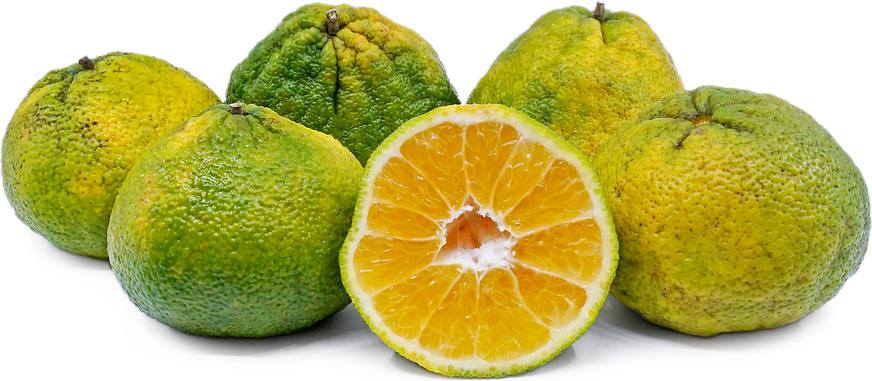


UGLI® Fruit
Estimated Inventory, cs : 0
Description/Taste
UGLI® fruits are a large citrus variety, averaging 10 to 15 centimeters in diameter, and have an irregular, oval to slightly flattened, oblate shape. The peel is semi-thick, leathery, and rough, covered in patches of russet, scars, bumps, and wrinkles. The fruits also bear variegated hues of green, yellow, and orange, and as the fruit matures, it will develop deeper yellow-orange shades, sometimes retaining green spots. It is important to note that green is not an indication of unripe fruit. The peel loosely clings to the flesh, easily removed, and the flesh is divided into 10 to 12 large segments, separated by fibrous membranes. The flesh also ranges in color from yellow to orange and is tender, aqueous, and succulent, either being found seedless or encasing a few cream-colored seeds. UGLI® fruits are aromatic with a light, lemon-like fragrance and have a sweet, subtly tangy flavor with fruity notes of pineapple, grapefruit, and oranges.
Seasons/Availability
UGLI® fruits are available for a limited season in the winter through early spring.
Current Facts
UGLI® fruits, botanically classified as Citrus reticulata x paradisi, are an unusual looking, seasonal citrus belonging to the Rutaceae family. The fruits were discovered in Jamaica growing as a natural tangelo mutation and are believed to have been developed from a grapefruit and Seville orange hybridization. UGLI® fruits were originally called the Exotic Tangelo from Jamaica, but over time, the fruit’s name was changed to UGLI® as a play on the fruit’s misshapen, lumpy appearance. Despite their lack of visual appeal, UGLI® fruits are known for their sweet, subtly tangy flavor and juicy, tender texture. The fruits are only harvested from the trees when ripe, allowing consumers to immediately eat the fruits after purchase. In addition to the large UGLI® fruits, new versions of the fruit have been created in a smaller size for snacking, marketed as UGLI® Baby fruit.
Nutritional Value
UGLI® fruit is an excellent source of vitamin C, an antioxidant that strengthens the immune system, reduces inflammation, and boosts collagen production within the skin. The fruits are also high in fiber to stimulate and cleanse the digestive tract and contain small amounts of calcium, potassium, and folate.
Applications
UGLI® fruits are easy-to-peel and have juicy, tender flesh, suitable for both fresh and cooked applications. The fruits can be sliced in half and eaten similarly to grapefruits, or they can be segmented and consumed straight, out-of-hand. UGLI® fruits can also be chopped and mixed into fruit bowls, citrus salads, and green salads, used as a fresh topping over yogurt and granola, or blended into smoothies. Beyond utilizing the flesh whole or in segments, the ample juice within the flesh can be extracted and combined into cocktails, sparkling fruit drinks, or other fresh beverages, or the juice can be used to flavor cheesecakes, bars, souffles, and ice creams. UGLI® fruits can also be combined into sauces to flavor savory main dishes, or the peel and juice can be cooked into marmalade. For a fresh dessert, the fruit can be sliced in half, coated in sugar and cinnamon, and broiled in the oven to develop a caramelized surface. UGLI® fruits pair well with meats such as pork, duck, and poultry, seafood such as mussels, shrimp, and fish, avocado, mushrooms, radicchio, chicory, sweet onions, fruits such as bananas, strawberries, and grapes, cinnamon, and herbs such as mint, cilantro, and parsley. Whole UGLI® fruits will keep up to 5 days at room temperature and up to 2 weeks when stored in the refrigerator.
Ethnic/Cultural Info
UGLI® fruit is grown on the Trout Hall estate in the parish of Claredon, located in Southern Jamaica. The family-owned property is comprised of over 3,000 acres of land and was once the site of a manufactured orange juice brand. The brand was later closed in the 1980s, but the estate switched to growing UGLI® fruits and sugar cane. When UGLI® fruit was discovered in the Brown’s Town area, budwood was planted in the Trout Hall estate and was bred over time to exhibit improved traits. The name UGLI® was created when a buyer called in and asked for “more of that ugly fruit,” and the name was quickly adopted and registered as an official title. UGLI® fruits are growing in popularity overseas, especially in Europe and North America, but despite their increased global demand, the fruits are not sold locally in Jamaica as a method of brand protection. The estate closely guards UGLI® fruit in an effort to prevent a rising local demand, which naturally causes increased competition and the desire of other growers to sell the fruits. Approximately one-third of the Trout Hall estate is dedicated to producing UGLI® fruits.
Geography/History
UGLI® fruits were discovered as a chance seedling in the early 20th century, growing naturally on a tree in a pasture near Brown’s Town in St. Ann’s Parish, Jamaica. The variety was discovered by G.G.R. Sharp and was planted in his estate, Trout Hall, for commercial cultivation. UGLI® fruits were first exported in the 1930s under Cabel Hall Citrus Limited, a company created by the Sharp family to market the fruits. Outside of Jamaica, the variety was grown and researched in Florida and California in the 1950s, but many of these test trees were destroyed, only saving a small amount of budwood for home garden cultivation. Today UGLI® fruits are primarily grown in Jamaica and are exported to Europe, Canada, and the United States, sold at specialty grocers and select supermarkets.
Recipe Ideas
Recipes that include UGLI® Fruit. One

















